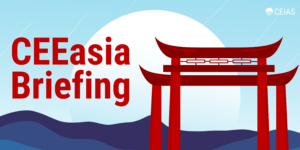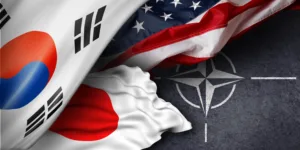The United States’ growing emphasis on fortifying the second island chain in the Indo-Pacific has sparked concerns about potential vulnerabilities in the first chain, prompting a reevaluation of regional defense strategies and alliances.
Key takeaways:
-
The US pivot towards the second island chain reflects its broader strategic recalibration in the Indo-Pacific in response to China’s growing military capabilities and influence in the region.
-
The emphasis on dispersed, resilient basing across the second island chain demonstrates a move towards more flexible and survivable military postures. This approach aims to counter emerging threats, such as long-range precision strikes, while maintaining strategic depth.
-
Increased US engagement with Pacific Island nations, particularly those in the second chain, suggests a recognition of these smaller states’ growing strategic importance.
US strategy and force posture
The first and second island chains are conceptual, strategic lines of islands in the Western Pacific that structure America’s containment strategy in East Asia. The first chain spans from Japan through Taiwan to the Philippines and Indonesia, forming a natural barrier along China’s eastern coastline. The second chain, located further east, extends from Japan through Guam and Micronesia to Indonesia, serving as a secondary defense perimeter. While the second chain is less densely populated and militarized than the first, it is a crucial geographical base for US power projection and potential deterrence of Chinese maritime expansion.
The views of Elbridge Colby, the influential undersecretary of defense for policy, reveal a tension between US strategic priorities and the dramatic deterioration of its military capabilities vis-à-vis China. While Colby has argued for a robust attack submarine presence within the first island chain, which he believes is crucial in preventing Chinese hegemony and maintaining regional stability, he has expressed skepticism about maintaining a permanent elevated US troop presence in the area. Despite acknowledging the first chain’s importance for containment, his preference for positioning US forces farther east risks rendering the region more vulnerable to Chinese naval ambitions, a position he attempts to justify by arguing that it’s neither fair nor viable for American servicemembers to bear the brunt of regional defense if allies aren’t adequately contributing to their own security.
The US is expanding its military infrastructure on key islands in the second chain, including Guam, Palau, and Tinian. This involves developing runways, deep-water ports, and air defense systems to secure American interests in the Indo-Pacific. Concurrently, the United States has begun relocating almost 9,000 Marine Corps personnel from Okinawa to Guam and Hawaii. While these efforts seek to consolidate US military power and provide a stronger deterrent against Chinese aggression, they also signal a shifting posture that could have wider implications for regional security. Prevailing logic suggests that dispersing forces to the second chain enhances their ability to cope against potential Chinese strikes but reduces the ability of the US military to respond within the first chain. This creates a dilemma: prioritizing distant but resilient positions in the second chain could embolden China to push harder against vulnerable allies in the first chain.
Marine Corps realignment and regional security
The relocation of forces from the first to the second chain, thus further from potential flashpoints, might be seen as weakening America’s deterrence capabilities closer to China’s shores. Indeed, Marine Corps Commandant General Eric Smith has expressed reservations about the move, warning that Guam’s distance from priority theaters will mean forces are too far away to deter Chinese aggression in the Indo-Pacific. Moreover, as the United States recapitalizes islands gained during World War II to form a series of strategic expeditionary points, it faces the challenge of balancing forward presence with force protection and operational resilience. Taiwan and other US allies in closer proximity to China may face increased pressure to bolster their own defenses, as the second island chain’s strategic depth complicates rapid response. Despite Taiwanese Defense Minister Wellington Koo’s assertion that it is “impossible” for the United States to retreat from the Asia-Pacific, recent developments suggest Washington is reassessing its priorities in the region. For some analysts, the move from the first to the second chain is a “strategic retreat” that could potentially embolden China to intensify its military activities around Taiwan.
The People’s Liberation Army Navy has already surpassed the US Navy in terms of ship numbers and continues to expand its presence in critical areas, such as the Taiwan Strait. China’s growing assertiveness has also drawn it into the “three-carrier era,” with one aircraft carrier in port for maintenance, another training in the South China Sea, and a third regularly deployed on the outer edge of the first island chain. The Pentagon’s “Military and Security Developments Involving the People’s Republic of China 2024” report highlights Beijing’s ongoing military modernization efforts, particularly in long-range precision strike capabilities. This includes the development of intercontinental ballistic missiles, such as the Dongfeng-31AG, which can reach targets as far as Hawaii, and intermediate-range ballistic missiles, like the Dongfeng-26, capable of striking Guam. These advancements enable China to challenge US positions within the first island chain and beyond, vying for dominance in the broader Indo-Pacific theater. Furthermore, China may be exploring conventionally armed intercontinental-range missile systems, which could potentially threaten targets in the continental United States, Hawaii, and Alaska. If Washington focuses too heavily on fortifying its presence in the second island chain, Beijing could exploit this gap by attempting a fait accompli invasion of Taiwan before US forces stationed farther away can respond effectively.
Taiwan’s challenges in a shifting Indo-Pacific
Taiwanese President Lai Ching-te’s administration continues to rely on the concept of the first island chain as a “psychological defense,” maintaining a hardline cross-strait stance. However, this strategy is increasingly at odds with the evolving strategic reality. Even US think tanks have expressed doubts about Taiwan’s ability to withstand a Chinese invasion, with a 2023 report by the Center for Strategic and International Studies suggesting that even with American and Japanese military intervention, Taiwan would only achieve a “Pyrrhic victory.”
The United States’ strategic pivot towards fortifying the second island chain is reshaping Indo-Pacific security dynamics, inadvertently exposing vulnerabilities along the First Island Chain. This ongoing shift, which includes expanding military infrastructure on key islands such as Guam and relocating Marine Corps personnel, signals concerns about regional security in the coming years. Specifically, it necessitates a reevaluation of defense strategies among key allies and partners in the face of China’s growing military capabilities and assertive posturing.
To address these challenges, Taiwan should adopt a multifaceted approach: strengthening asymmetric defense capabilities through investments in drones, surface-to-air missiles, and land-based anti-ship missiles; deepening economic and cultural ties with Indo-Pacific nations through the New Southbound Policy, which has already increased bilateral trade by 88.2 percent between 2016 and 2022; and enhancing cooperation with like-minded democracies through initiatives such as the Taiwan-Pacific Summit and participation in the Pacific Islands Dialogue. This strategy can help maintain Taiwan’s security and counter China’s growing influence by leveraging shared values and interests with regional partners.







